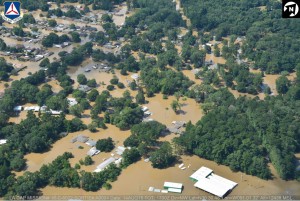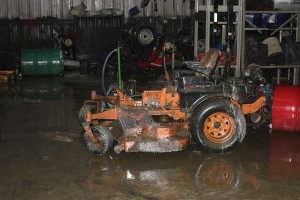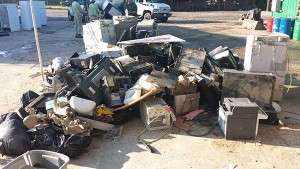
From Aug. 8-14, 6.9 trillion gallons of rain pummeled Louisiana’s Baton Rouge area. One month after the worst natural disaster since Hurricane Sandy, one local landscape company is still treading water.
Chris Casselberry owns GreenSeasons and a Spring-Green franchise in Central, La., which borders Baton Rouge and falls in East Baton Rouge Parish. Despite the companies’ headquarters taking in 8 feet of water, they are almost fully operational, though the administrative staff is operating out of a temporary office. Getting to that point wasn’t easy or cheap, and the future is still uncertain.
“We had absolutely nothing when it was all over with,” Casselberry said. “We lost somewhere around 150 pieces of equipment and 43 trucks. We lost also 200 or 300 pieces of smaller equipment—weed eaters, edgers, blowers, small tools.”
From day one, the priority was getting back to operational, Casselberry said. Assessing the damage, taking inventory and salvaging equipment consumed the first two days.

“The first thing we wanted to do is get back onto our land, assess and start cleaning up so we could tell what kind of tools, trucks—what we had,” he said. “The first two days, all we did was pressure wash, clean, knock down stuff, drag trucks that were damaged out of the water. (It was about) just seeing what was operating.”
GreenSeasons’ employees played a big role in helping get it back up and running. Cell phones were spotty but mostly reliable enough for Casselberry to reach out to his staff. He said the company was fortunate to have a large staff of H-2B workers, who, with no nearby family or friends to take care of, had time to help out. Some of the workers’ provided housing flooded, but the company moved them into other housing.
About 50 percent of GreenSeasons’ American workers were unaffected by the flood. Those who did experience flooding or had family members devastated by the flood, were given the necessary time off.
“This has never happened before, so we didn’t have a policy, but we do have compassion,” Casselberry said. “We told them, ‘If you or your family are flooded, that comes first. Just keep us posted to when you can come back.’ Once they do come back, they can have time off to take care of personal issues, deal with insurance and stuff like that.”
By day three, the company was able to send a few salvaged trucks to service clients in less affected areas. Over the next two weeks, GreenSeasons rented 12 trucks and borrowed two or three more from nearby Spring-Green franchises. It was forced to buy 37 brand new trucks and a myriad of new pieces of equipment, like mowers and blowers, to return to a full fleet.
Securing a replacement office was the next urgent task.
“With a disaster this big, everybody is in the same boat,” he said. “We wanted to make sure we found a temporary office before it was gone, so we could bring our administrative and sales staff to a place where they could operate.”

In addition to field equipment and the structure that housed the administrative office, the flood took phones, hard drives, paper files and computers. Fortunately, the company had its data and files backed up to a cloud-based storage system. A data recovery firm is still working on rebuilding its files from its damaged servers.
The recovery was costly. The initial clean-up cost more than $50,000. The new trucks cost more than $1 million. Additional costs are still rolling in as the company replaces miscellaneous tools and equipment. The temporary office is an additional cost of $1,500 a month. Casselberry expects to operate out of the temporary office well into 2017. Past that, the future is uncertain.
GreenSeasons’ insurance claim will surpass $3 million, Casselberry said. The company was covered by flood insurance, a requirement in a Special Flood Zone; flood contents insurance, which covers pre-listed contents inside the structure such as computers; collision and comprehensive vehicle insurance, the latter of which covered flooding; and commercial inland marine policy insurance, which covered pre-listed equipment.
“We’re waiting for them to make the recommendations for us or do their evaluations so they can start paying us something,” he said.
Right now, affected companies are stuck in a bit of a waiting game. The Federal Emergency Management Agency (FEMA), local and state government officials and insurance companies are overwhelmed with claims. On Aug. 22, more than 25,000 National Flood Insurance Program policy holders had submitted claims for flood loss, according to FEMA. The agency recently extended the grace period to renew flood insurance policies to help deal with the large number of claims.
“We have no idea how long because you’ve got to deal with FEMA, the city, the state and the parish,” Casselberry said. “So when you’re dealing with a lot of government agencies and a massive amount of loss, nobody knows just what way you’re going to do things.”
GreenSeasons falls in a Special Flood Hazard Zone—along with 42 percent of East Baton Rouge Parish, according to the city of Central, La. The building was substantially damaged, meaning the total cost of repairs is 50 percent or more than the structure’s worth. When a structure in a Special Flood Hazard Zone is substantially damaged, as determined by local government officials, it must be rebuilt or rehabilitated to comply with certain requirements. In many cases, this means elevating the structure above a potential flood grade. Failure to comply is often met with a denial of building permits and flood insurance, which is a requirement for businesses and residences in Special Flood Hazard Zones.
“You can’t get permitted to rebuild when you have that much water damage in your property, so we won’t be able to rebuild without raising the building, which is a nightmare,” Casselberry said. “Our building is so big, (we’ll) have to tear it down and rebuild it up.”
Still, the Spring-Green and GreenSeasons owner is pushing forward. Plans for a newly constructed building are already in the works.
“We already reached out to someone building a modular building, where we could put it on stilts. We had 8 feet of water, (so) we’ll build it 8 feet high,” he said. “There are many ideas, but whatever we do, we want to make sure we won’t flood again.”
Photos: Louisiana Civil Air Patrol, GreenSeasons/Spring-Green

